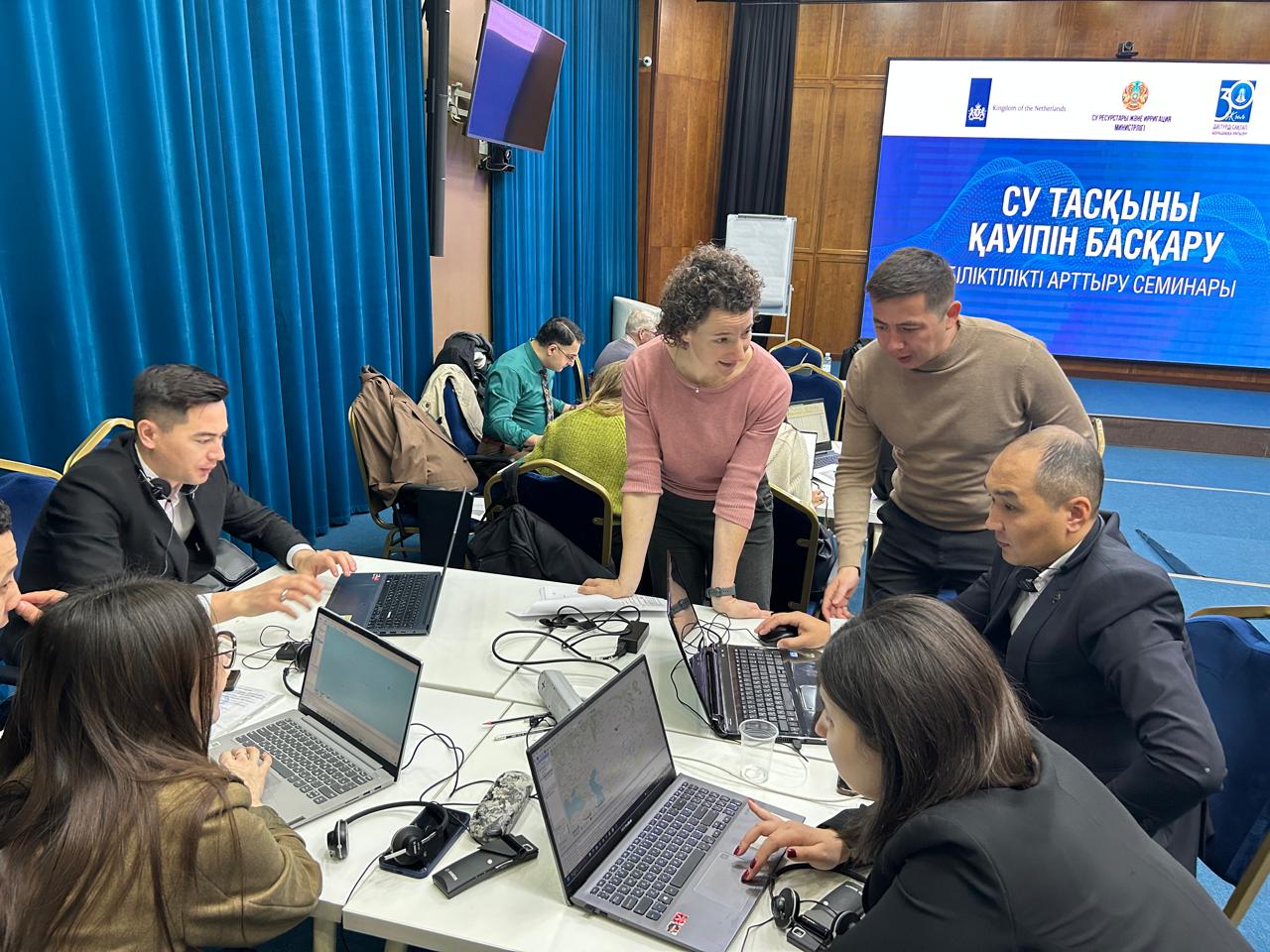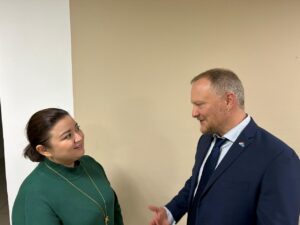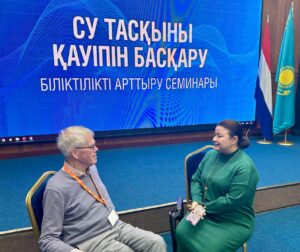ASTANA — Key stakeholders in water and flood management from the Netherlands and Kazakhstan, including representatives from the Kazakh Ministry of Emergency Situations, the Ministry of Water Resources and Irrigation, and the Institute of Geography and Water Security, gathered for the final training of the year on Oct. 24.

DRRS team worked closely with Kazakh authorities to map and predict flood risks. Photo credit: The Astana Times
This collaboration continues the support provided by the Netherlands during the floods in April. The Dutch Disaster Risk Reduction and Surge Support (DRRS) team worked closely with Kazakh authorities to map and predict flood risks.
Fredrik Huthoff, associate professor of Hydraulic Engineering at IHE Delft Institute for Water Education and a key representative of the DRRS team, highlighted the potential for collaboration between the two countries.
“We are seeing a lot of possible synergies in bringing the skills and information from these institutions together. For example, when it comes to observations from space. There is a lot that can be done already to be better prepared for flood situations,” he said.
Satellite technology fills data gaps in flood prediction efforts
Huthoff noted that Kazakhstan’s vast size makes it challenging to measure water conditions consistently at key points. It is not feasible to monitor everything everywhere all the time, but remote sensing and satellite observations can help fill gaps in certain areas.

Huthoff, a key representative of the DRRS team, stressed the importance of an early warning system, which relies on understanding the physics of floods. Photo credit: The Astana Times
“You can observe where the water is, and with modern technologies, you can even estimate quantities from space. These are areas where different institutions can work together better to improve insights on flood situations and be better prepared for the future,” he said.
Huthoff explained that filling these gaps means bridging the spatial data gaps in water information.
“For example, there are hydrometeorological ground stations that measure rainfall or water levels in rivers at specific points. But these are point locations, and large areas in between are not measured on the ground,” he said.
“To get a complete picture of how a flood moves from one place to another, it is important to have information from those locations in between, which can be filled with observations from space. Combining ground measurements with satellite observations allows us to create a comprehensive picture of how floods are developing. There are significant opportunities in this approach,” he added.
Huthoff also stressed the importance of an early warning system, which relies on understanding the physics of floods and using that knowledge in models to predict when and where floods will occur.
“In Kazakhstan, some of these models and techniques already exist, but they can be expanded and applied to other areas as well. We are exploring ways to achieve this, and it comes down to having accurate information about the current situation and using our understanding of physical and hydrological processes to make future predictions,” he said.
He added that space observations and radar technology are valuable tools for detecting rain.
“Radar can look through the atmosphere and detect where rain is falling. There are already several radar stations in Kazakhstan, but the information from these stations is not being fully utilized for rainfall measurements. That is an opportunity — the equipment is there, but it is not being used to its full potential. We’re also making recommendations on how to optimize these aspects,” he concluded.
Cross-ministry collaboration key to improved land use and water management
Rieks Bosch, an expert with the DRRS team, discussed the challenges posed by climate change in Kazakhstan.
“One of the issues is the changing climate. While you cannot control the climate itself, you can adapt to the associated risks, such as land degradation and water overuse,” Bosch explained.
He emphasized the need for increased cooperation between the ministries.
“A lot of the solutions are like open goals — simple measures, such as using satellite spatial data, can promote collaboration between the water and agriculture sectors to retain water on land, reducing runoff. This requires forestry, agriculture, and other sectors to work together,” he noted.

Bosch, an expert with the DRRS team, said land degradation is an even bigger threat than climate change
Photo credit: The Astana Times
Bosch also mentioned that a significant challenge is the lack of clear responsibilities between agencies.
“I spoke with some agencies and they are unsure where their responsibilities begin and end because these borders are not clearly defined by the government. Once these are set, cooperation will improve significantly,” he said, noting the opportunities for improvement in this area.
A temporary working group in Kazakhstan was established two years ago following an orientation mission. Bosch suggests turning this group into a permanent body where decision-makers from various ministries can collaborate and make informed decisions for the government.
“We are currently proposing and training for a common knowledge-based system where everyone can work together. This also requires harmonization between ministries,” Bosch added.
Dutch experts highlight climate adaptation challenges in Kazakhstan
Discussing climate patterns in Central Asia, including Kazakhstan, Bosch pointed out how extreme temperatures are rising faster than average temperatures.
“Efforts to focus solely on average temperatures do not address the full picture. For example, when extreme temperatures increase by three degrees, asphalt designed for 36 degrees Celsius now has to withstand 39 degrees, or it melts. Additionally, early spring heat waves can prevent crops from blooming, affecting the harvest,” he explained.
Bosch also highlighted the risk of spring floods due to lower-altitude snowfall, which melts more quickly. He noted that the current buffer system for managing floods can handle only about 45% of the flood risk.
“The remaining 55% has to come from better land use. Water needs to be retained in the ground, rather than running off. This involves cooperation with agriculture and revisiting old regulations on runoff protection, such as creating forest belts and small dams,” he said.
Many of these practices were abandoned after privatization in the 1990s, but Bosch suggested they should be revived.
“This requires cooperation between ministries to harmonize regulations on water management and land use,” he added.
He also addressed drought periods, which are lengthening, particularly in southern Kazakhstan.
“In some places, the drought period has extended by two weeks, which makes a huge difference. Evaporation rates are increasing due to the higher temperatures, meaning more water is needed for agriculture. Population growth is also putting additional strain on water resources, with more demand for drinking water and industry,” Bosch explained.
However, he emphasized there are opportunities to save water, particularly in agriculture. Bosch also strongly emphasized that land degradation is a major issue.
“Land degradation is an even bigger threat than climate change. In the hills near Almaty, it is caused by overgrazing, but in the north, it is due to undergrazing. There are not enough animals on the wild steppes, leading to less vegetation and more runoff, increasing flood risk. Land degradation can triple the hazard risk, so improving the land will be a crucial tool for climate adaptation,” Bosch said.
He highlighted a proposal to help local populations by reintroducing herds of domestic animals to replace wild ones, giving the land time to recover.
“Reforestation and land improvement are key strategies to combat degradation. The good news is that this problem is manageable. With the right efforts, it can be reversed. We are also preparing a proposal for agricultural projects involving Dutch investment funds, with the hope of expanding them to larger areas like Aktobe, where reforestation efforts are underway,” Bosch concluded.


